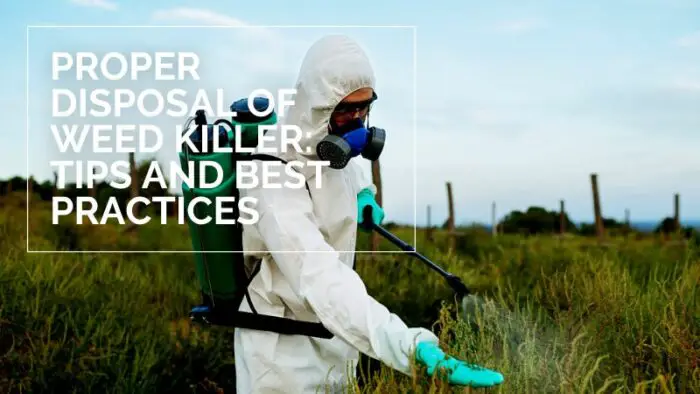You can throw away weed killer. However, it is essential to dispose of weed killer properly to ensure that it does not harm the environment or pose a risk to human health. Here are some steps to follow when disposing of weed killer:
- Check the label: The label on the weed killer container should provide instructions for disposal. Follow these instructions carefully.
- Wear protective gear: When handling weed killers, it is essential to wear protective equipment such as gloves, long sleeves, and eye protection to prevent accidental exposure.
- Don’t pour it down the drain: Never pour weed killer down the drain or flush it down the toilet. This can contaminate the water supply and harm aquatic life.
- Dispose of it at a hazardous waste facility: Many communities have hazardous waste facilities where you can safely dispose of weed killer and other potentially dangerous chemicals. Check with your local government or waste management agency to find out where to bring weed killer for proper disposal.
- Consider alternatives: Before using weed killer, consider other options for controlling weeds, such as manual removal, mulching, or using natural herbicides. These methods may be less toxic and safer for the environment.
It is essential to dispose of weed killers properly to prevent them from harming the environment or posing a risk to human health. By following these steps, you can ensure that weed killer is disposed of safely and responsibly.
What Happens if Weed Killer is Disposed of Improperly?
If weed killer is disposed of improperly, it can negatively affect the environment and human health. Here are some potential impacts of improper disposal of weed killer:
- Contamination of water sources: If weed killer is poured down the drain or flushed down the toilet, it can enter the water supply and contaminate lakes, rivers, and other bodies of water. This can harm aquatic life and make the water unsafe for human consumption.
- Pollution of soil: If weed killer is poured onto the ground or thrown into the trash, it can leach into the soil and contaminate it. This can have negative impacts on plants and other organisms in the soil.
- Exposure to humans and animals: If weed killer is not disposed of properly, it can pose a risk to humans and animals who come into contact with it. Inhaling the fumes or getting the chemical on your skin or eyes can cause irritation and other health problems.
Proper disposal of weed killers is important to protect the environment and human health. It is important to follow the instructions on the label and dispose of weed killer at a hazardous waste facility to ensure that it is handled safely.

Where to Dispose of Weed Killer
The best way to dispose of weed killer is to take it to a hazardous waste facility. Many communities have facilities specifically designed to safely dispose of potentially hazardous materials, such as weed killers. These facilities are equipped to handle the chemical safely and prevent it from contaminating the environment.
To find out where to dispose of weed killer in your area, you can contact your local government or waste management agency. They should be able to provide information on the nearest hazardous waste facility and any special instructions for disposing of weed killer.
It is essential to follow the instructions on the label of the weed killer container and to handle the chemical carefully to prevent accidental exposure. Wear protective gear such as gloves, long sleeves, and eye protection when handling weed killer, and never pour it down the drain or flush it down the toilet.
Recycling or Repurposing Empty Weed Killer Containers
Recycling or repurposing empty weed killer containers is a responsible and environmentally-friendly way to dispose of them. Here are a few options for recycling or repurposing empty weed-killer containers:
- Check with your local waste management company to see if they have a program for recycling plastic containers. Many communities have facilities that recycle plastic containers, including those previously held weed killers.
- Contact the manufacturer of the weed killer to see if they have a program for recycling or repurposing their containers. Some companies may have a take-back program or other options for responsibly disposing of their containers.
- Consider reusing the container for a different purpose. Empty weed-killer containers can store tools, small household items, or even a makeshift planter for herbs or flowers. Just be sure to thoroughly clean and rinse the container before using it for a new purpose.
- Donate the container to a school or community garden. These organizations may be able to use the container for storage or other purposes, and it’s a great way to give the container a new life.
By recycling or repurposing empty weed-killer containers, you can help to reduce waste and protect the environment. It’s essential always to follow proper disposal guidelines and to use caution when handling weed killer or any other potentially hazardous substance.
Using Natural or Organic Alternatives to Weed Killer
Using natural or organic alternatives to weed killer is a safer and more environmentally-friendly way to control weeds in your garden or lawn. Here are a few options to consider:
- Hand-pulling weeds: This is the most labor-intensive option, but it can be effective for small areas or spot-treating individual weeds. Pull the entire root to prevent the weed from growing back.
- Mulching: Mulch can help to suppress weed growth by blocking sunlight and preventing weed seeds from germinating. Use a thick layer of mulch around plants and garden beds to help control weeds.
- Cover cropping: Planting a cover crop, such as clover or ryegrass, can help to suppress weed growth and add nutrients to the soil. When the cover crop is no longer needed, it can be mowed down and incorporated into the soil.
- Boiling water: Boiling water can kill weeds in small areas, such as between pavers or crevices. Be careful not to get the water on desirable plants, as it will also kill them.
- Homemade weed killer: Many natural ingredients can be used to make homemade weed killers, such as vinegar, lemon juice, and salt. These natural alternatives may be less effective than chemical weed killers, but they are safer for the environment and less toxic to humans and pets.
Using natural or organic alternatives to weed killer, you can effectively control weeds while minimizing the impact on the environment and your health.
Conclusion
It’s essential to dispose of weed killer properly to ensure that it does not harm the environment or pose a risk to human health. The best way to dispose of weed killer is to take it to a hazardous waste facility equipped to handle the chemical safely.
To find out where to dispose of weed killer in your area, you can contact your local government or waste management agency. When handling weed killers, it is essential to wear protective gear and follow the instructions on the label to prevent accidental exposure. Consider using alternative methods for controlling weeds, such as manual removal, mulching, or natural herbicides, to reduce the need for potentially toxic chemicals.

